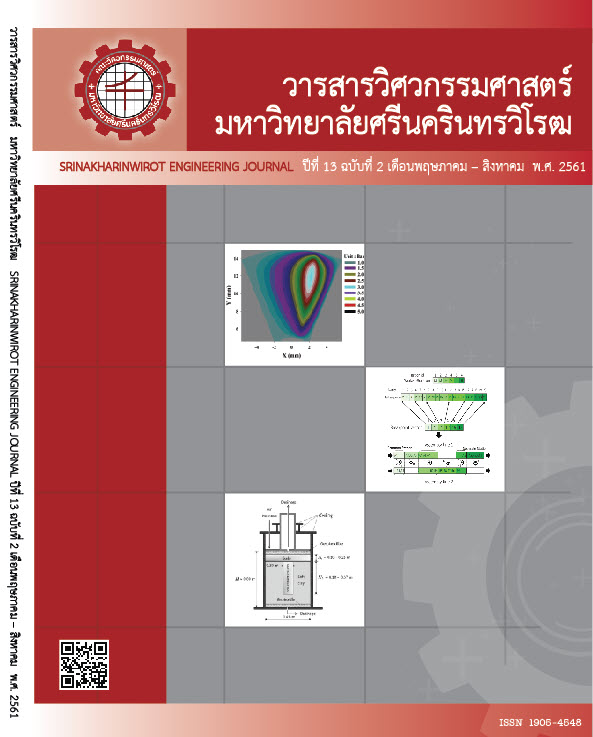Influence of Solvents Used for Cassava Rhizome Pretreatment on Fast Pyrolysis Products
Main Article Content
Abstract
Three solvents including water, hexane and acetone were used to pretreat cassava rhizome. The pretreated biomass samples had lower extractives content compared to the non-extracted one. The pretreated samples together with the original biomass were fast pyrolysed in a fluidised bed reactor producing bio-oil, char and gas. The results showed that after extraction with water, hexane and acetone, the yields of total bio-oil, heavy bio-oil and gas increased at the expense of light bio-oil and char yields. A maximum total bio-oil yield of 54 wt% was achieved when using water as solvent. Based on the property analyses, all solvents hardly affect the pH, solids content, ash content and density of bio-oils. However, hexane and acetone could increase the bio-oil heating value. In addition, the flash point, fire point, hydrogen and oxygen contents were increased by the solvent extraction, whereas the carbon content of bio-oil reduced except when using acetone.
Article Details
Copyright belongs to Srinakharinwirot University Engineering Journal
References
[2] S. Sirijanusorn, K. Sriprateep and A. Pattiya, “Pyrolysis of cassava rhizome in a counter-rotating twin screw reactor unit, ” Bioresour. Technol., vol. 139, pp. 343-348, Jul. 2013.
[3] M. Melzer, J. Blin, A. Bensakhria, J. Valette and F. Broust, “Pyrolysis of extractive rich agroindustrial residues, ” J. Anal. Appl. Pyrolysis, vol. 104, pp. 448-460, Nov. 2013.
[4] T. Suchithra, S. Adhikari, H. Ravindran, R. B. Gupta, O. Fasina, M. Tu, S. D. Fernando, “Physiochemical properties of bio-oil produced at various temperatures from pine wood using an auger reactor, ” Journal of Bioresour. Technol., vol. 101, no. 21, pp. 8389-8395, 2010.
[5] R. Fahmi, A. V. Bridgwater, I. Donnison, N. Yates and J. M. Jones, “The effect of lignin and inorganic species in biomass on pyrolysis oil yields, quality and stability, ” J. Fuel, vol. 87, no. 7, pp. 1230-1240, 2008.
[6] K. Duanguppama, N. Suwapaet and A. Pattiya, “Fast pyrolysis of contaminated sawdust in a circulating fluidised bed reactor, ” J. Anal. Appl. Pyrolysis, vol. 118, pp. 63-74, Mar. 2016.
[7] B. Pidtasang, P. Udomsap, S. Sukkasi, N. Chollacoop and A. Pattiya, “Influence of alcohol addition on properties of bio-oil produced from fast pyrolysis of eucalyptus bark in a free-fall reactor, ” J. Ind. Eng. Chem., vol. 19, no. 6, pp. 1851-1857, 2013.
[8] K. Raveendran, A. Ganesh and K. C. Khilar, “Influence of mineral matter on biomass pyrolysis characteristics, ” J. Fuel, vol. 74, no. 12, pp. 1812-1822, 1995.
[9] S. W. Kim, B. S. Koo and D. H. Lee, “Catalytic pyrolysis of palm kernel shell waste in a fluidized bed, ” Bioresour. Technol., vol. 167, pp. 425-432, Sep. 2014.
[10] บุญสิริ ปิตตาแสง, สิทธา สุขกสิ, และ อดิศักดิ์ ปัตติยะ, “ผลของอัตราการป้อนชีวมวลต่อผลิตภัณฑ์จากกระบวนการไพโรไลซีสแบบเร็วโดยใช้เตาปฏิกรณ์แบบตกอิสระ, ” วารสารวิทยาศาสตร์และเทคโนโลยีมหาวิทยาลัยมหาสารคาม, ปีที่ 32 ฉบับบที่ 4, หน้า 499-503, กรกฎาคม-สิงหาคม 2556.
[11] P. Kaewpengkrow, D. Atong and V. Sricharoenchaikul, “Catalytic upgrading of pyrolysis vapors from Jatropha wastes using alumina, zirconia and titania based catalysts, ” Bioresour. Technol., vol. 163, pp. 262-269, Jul. 2014.
[12] A. Pattiya, J. O. Titiloye and A. V. Bridgwater, “Evaluation of catalytic pyrolysis of cassava rhizome by principal component analysis, ” J. Fuel, vol. 89, no. 1, pp. 244-253, 2009.
[13] M. Nik-Azar, M. R. Hajaligol, M. Sohrabi and B. Dabir, “Mineral matter effects in rapid pyrolysis of beech wood, ” Fuel Process. Technol., vol. 51, no. 1-2, pp. 7-17, 1997.
[14] X. Guo, S. Wang, K. Wang, Q. Liu and Z. Luo, “Influence of extractives on mechanism of biomass pyrolysis, ” J. Fuel Chem. Technol., vol. 38, no. 1, pp. 42-46, 2010.
[15] S. D. Stefanidis, K. G. Kalogiannis, E. F. Iliopoulou, C. M. Michailof, P. A. Pilavachi, and A. A. Lappas, “A study of lignocellulosic biomass pyrolysis via the pyrolysis of cellulose, hemicellulose and lignin, ” J. Anal. Appl. Pyrolysis, vol. 105, pp. 143-150, Jan. 2014
[16] G. Yildiz, F. Ronsse, R. Venderbosch, R. v. Duren, S. R. A. Kersten and W. Prins, “Effect of biomass ash in catalytic fast pyrolysis of pine wood, ” Appl. Catal., B, vol. 168–169, pp. 203-211, Jun. 2015.
[17] ณัฐพันธ์ พรหมสำเภา, นุชิดา สุวแพทย์, และ อดิศักดิ์ ปัตติยะ, “การผลิตไบโอออยล์จากการไพโรไลซีสแบบเร็วของกากเปลือกเมล็ดมะเยาหินและกากเมล็ดปาล์มโดยใช้เครื่องปฏิกรณ์ฟลูอิไดซ์เบดแบบฟอง, ” วารสารวิศวกรรมศาสตร์ มหาวิทยาลัยศรีนครินทรวิโรฒ, ปีที่ 9 ฉบับที่ 2, หน้า 23-32, กรกฎาคม-ธันวาคม 2557.
[18] Y.A. Cengel and M.A. Boles, Thermodynamics: An Engineering Approach, New York: McGraw-Hill, 2006.
[19] S. R. G. Oudenhoven, R. J. M. Westerhof, and S. R. A. Kersten, “Fast pyrolysis of organic acid leached wood, straw, hay and bagasse: Improved oil and sugar yields, ” J. Anal. Appl. Pyrolysis, vol. 116, pp. 253-262, Nov. 2015.
[20] A. Pattiya and S. Suttibak, “Fast pyrolysis of sugarcane residues in a fluidised bed reactor with a hot vapour filter, ” J. Energy Inst., vol. 90, no. 1, pp. 110-119, 2015.
[21] Y. Wang, L. Wu, C. Wang, J. Yu, and Z. Yang, “Investigating the influence of extractives on the oil yield and alkane production obtained from three kinds of biomass via deoxy-liquefaction, ” Bioresour. Technol., vol. 102, no. 14, pp. 7190-7195, 2011.


